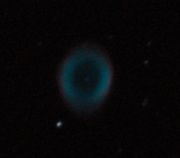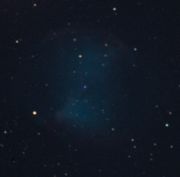Planetary nebula
Despite their name, planetary nebulae have nothing to do with planets. They gained this moniker in the nineteenth century when they were first observed. Through the telescopes of the day, they looked similar to the planets Neptune and Uranus and it was through spectroscopy that it was discovered that they weren't planets. What planetary nebulae really are is much grander. Planetary nebulae are the ejected outer layers of stars that are near the end of their lives.
Contents |
Formation
When a star from about half to about four times the mass of our Sun has spent most of the nuclear fuel in its core it moves off the main sequence and becomes a red giant. This red giant eventually becomes an asymptotic giant branch star. High temperatures in the core of these stars cause them to eject or blow off their outer layers leaving behind the hot core of the star. Stellar winds help push this expanding bubble of gas further and further from the star. As these outer layers move away from the star, the large amount of ultraviolet radiation from the hot core excites the ejected gas and causes it to glow. It is this glowing, expanding gas that we see as the planetary nebula[1].
Cause for variation in shapes
Now if a spherical object such as a star were to blow off a layer or two of gas, one would quite rightly assume that the resulting form the gas would take would also be spherical like a soap bubble. Such a bubble could look like a disk or a ring from Earth as these shells would be quite thin and we would be able to see through all but the edge of the expanding bubble. There are planetary nebulae that look like this. However, most planetary nebulae don't look like rings, but have shapes more like butterflies or dumbbells, M27 being typical of these. The spherical model doesn't work for these planetaries and there have been several theories to explain them. Fact some of the ring and round planetary nebulae are also butterfly shaped, just seen end on. M57 - the Ring Nebula is an example of this, with it's shape being similar to M27, just seen from the end[2].
The first theory was proposed was that the stellar wind was being confined by a toroidal or doughnut shaped ring of matter around the equator of the star. This ring would funnel the winds out the poles of the star causing the ejected matter to form lobes. The difficulty with this model is that most stars of about the Sun's size aren't rotating fast enough to do this. It would require that the dying star have a companion star to help provide the angular momentum to create the disk. Few if any companions have been seen near planetary nebulae so this is a weakness in this model.
Other models look at ways the dying star could create the confining torus without a companion. Many of these have the star creating a magnetic field around its equator that would then trap particles and force the winds to exit via the polar regions. This would then cause the star to form a planetary nebula in the dumbbell or butterfly shape. There is much debate over this model though as it is unclear if stars of the size that cause planetary nebulae can create a magnetic field strong enough to form a torus.[3]
So the reason for the variation in shapes is still under debate in the scientific community. Only more observations and time will bring us closer to a model that fits.
So where are they all?
Since it is thought that stars that are around the Sun's mass create planetary nebulae, one would expect to see them littering the galaxy. It is estimated that there could be upwards of 50 000 planetary nebulae in our galaxy[1], but in a galaxy with upwards of 100 billion stars, that's not a very large number. So where all the planetary nebulae? The answer is surprisingly simple. The shells of gas around planetary nebulae expand rather quickly by astronomical standards. This means that it takes less than about 100 000 years for the gas to have disbursed to the point of invisibility (most planetary nebulae observed seem to be less than 50 000 years old). In astronomical terms, 100 000 years isn't a lot of time so at any given point, there's simply not a lot of planetary nebulae around to look at.[4]
Importance in the Galaxy
Planetary nebulae provide a significant source of heavier elements in the galaxy. As a result of the nuclear reactions in the core of stars, elements heavier than hydrogen and helium are created. In very large stars, these are sent into space during a supernova explosion. For smaller stars, these elements are blown off the star during the formation of planetary nebulae. In fact it is estimated that mass equivalent to five Suns is sent into the galaxy each year by planetary nebulae. This constitutes upwards of 15% of the total mass sent in to space by all processes which means that planetary nebulae are an important source of heavier elements[1].
Classification
As with open and globular clusters there are ways of classifying planetary nebulae. The most common way is to use the system developed by Soviet astronomer Boris Vorontsov-Velyaminov. This has six main classifications with a few sub-types.
| Classification | Description |
|---|---|
| I | Stellar image |
| II | Smooth Disk |
| IIa - Smooth disk, brighter towards centre | |
| IIb - Smooth disk, uniform brightness | |
| IIc - Smooth disk, traces of ring structure | |
| III | Irregular disk |
| IIIa - Irregular disk, very irregular brightness distribution | |
| IIIb - Irregular disk, traces of ring structure | |
| IV | Ring structure |
| V | Irregular form, similar to diffuse nebula |
| VI | Anomalous form |
References
- ↑ 1.0 1.1 1.2 Freedman, Roger A and Kaufmann, William J, Universe, 8th Ed.
- ↑ Kowk, Sun; Chong, Sze-Ning; Koning, Niko; Hua, Trung; and Yan, Chi-Hung, "The True Shapes of the Dumbel and the Ring", The Astrophysical Journal, 2008, 689:219-224
- ↑ Balick, Bruce and Frank, Adam, Shapes and Shaping of Planetary Nebulae, Annual Review of Astronomy and Astrophysics, 2002, 40:439-486
- ↑ Abell, George O., Exploration of the Universe, 4th Ed
- ↑ http://www.blackskies.org/class1.htm, Planetary Nebula Classification, accessed 25 January 2008.

